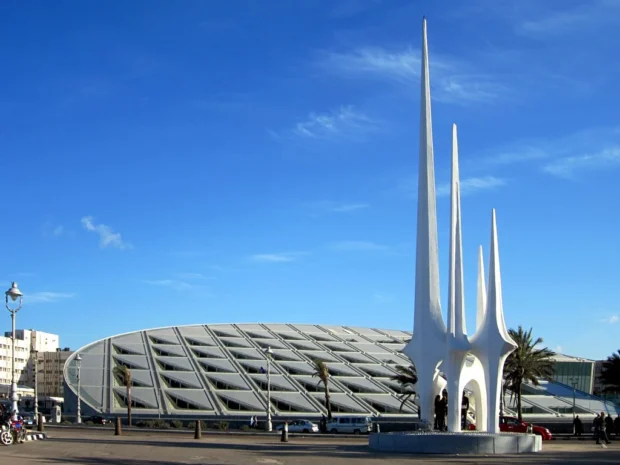In the heart of Alexandria, Egypt, stands the Bibliotheca Alexandrina, a modern tribute to the ancient world’s most famous library. This cultural hub draws visitors eager to experience its rich history, vast collections, and innovative architecture. If you are curious about Alexandria’s treasures, local Egyptian food, or need travel advice from the city center, airport, or train station, this guide will help you get the most from your visit. Nearby, you will find charming lodging options and lively local eateries serving favorites like fresh seafood and koshari. Let’s take a warm and insightful look at this iconic library’s story, visitor tips, and how to access this extraordinary place.
Table of Contents
How to Reach Bibliotheca Alexandrina Easily
Getting to Bibliotheca Alexandrina is straightforward, whether you start from Alexandria’s city center, the main airport, or the train station. If you are in the city center, a short taxi or bus ride will take you along the beautiful corniche road toward the library by the Mediterranean shore.
Visitors arriving by plane at Borg El Arab Airport can take a taxi directly to the library. The ride typically lasts around 40 minutes depending on traffic. From the Alexandria train station, shared minibuses or taxis are available, usually costing just a few Egyptian pounds.
For those who prefer public transport, local buses with signs for Shatby or Raml Station pass near the library area. Walking from downtown can take about 30 minutes along the coast, rewarding travelers with great views of the sea and city life.
Where to Stay and Taste Local Alexandria Flavors
Near the Bibliotheca Alexandrina, there are many guesthouses and hotels suitable for different budgets. Most feature easy access to the library and scenic walks by the sea. Staying nearby allows you to enjoy evening strolls along the corniche or visit local markets full of fresh fruits and spices.
When it comes to food, Alexandria offers delightful options. Try freshly grilled fish at seaside cafes, or sample koshari, Egypt’s famous street dish made of rice, lentils, and pasta with a spicy tomato sauce. Local bakeries serve sweet basbousa and chewy baklava that make perfect treats after your visit.
History and Importance of Bibliotheca Alexandrina
The Bibliotheca Alexandrina is not just a building; it is a powerful symbol of knowledge and cultural exchange. It honors the ancient Library of Alexandria, once the largest and most significant library in the ancient world, housing scrolls and manuscripts from multiple civilizations. That original library, founded in the 3rd century BCE, was a place where scholars gathered to study everything from philosophy to astronomy.
The modern library opened its doors in 2002 to revive that spirit of learning and make knowledge accessible to the public. It holds millions of books, a planetarium, specialized museums, and research centers. Its unique circular design resembles a rising sun, symbolizing enlightenment and hope.
After exploring Alexandria’s cultural heart at the Bibliotheca Alexandrina, many travelers find it inspiring to visit another iconic Egyptian landmark by heading to Cairo to see the Great Sphinx, a timeless symbol of ancient mystery and art. Read more about ways to reach the Great Sphinx in Cairo to plan a seamless transition between these unforgettable sites.
If your journey through Egypt continues beyond Alexandria, exploring the sun-soaked resorts and vibrant markets of Sharm El Sheikh Egypt offers a perfect mix of beach relaxation and rich local culture to enrich your travels.
After exploring the impressive collections and architecture of the Bibliotheca Alexandrina, you might enjoy a visit to Pompey’s Pillar, a striking Roman monument just a short trip away, offering a different glimpse into Alexandria’s deep history and coastal charm.
The ancient library’s enduring myth
Many legends surround the ancient library, including stories of how its destruction led to the loss of invaluable knowledge. Some say Julius Caesar’s fire in 48 BCE damaged it, while others claim later events contributed to its fall. The current Bibliotheca aims to restore that sense of wonder and intellectual richness.
Planning Your Visit: Best Times and Days
To enjoy the Bibliotheca Alexandrina calmly and without crowds, visit on weekdays, especially Tuesday to Thursday. Weekends can be busy with families attending workshops and cultural events. The library opens in the morning around 9 AM and usually closes by 7 PM; however, check their official calendar for special events or holiday hours.
The best months to visit Alexandria are between October and April when the weather is mild. Summers can be hot and humid, so morning visits are recommended during that season. Consider arriving early to have a peaceful tour and better photo opportunities, especially with the Mediterranean light.
Tour and Reservation Requirements at Bibliotheca Alexandrina
Visitors can explore the library freely without advance booking for general access. However, if you want to join guided tours, attend special exhibitions, or use research facilities, it is wise to reserve ahead. Guided tours offer fascinating insights from knowledgeable staff who explain the library’s design, collections, and cultural events.
Reservations can be made by phone or online through their official website. Some workshops or planetarium shows require tickets, so checking ahead ensures you don’t miss out on popular activities. Entry fees are reasonable, with discounts for students and group visits.
Extra activities worth noting
- Attend lectures on Egyptian history and science hosted in the library’s conference halls.
- Visit specialized museums inside, such as the Manuscripts Museum or the Antiquities Museum.
- Explore the planetarium to watch shows about stars and the cosmos-a favorite for families and curious minds alike.
Hidden Stories and Surprises at the Library
Many visitors don’t realize that the Bibliotheca Alexandrina is home to some rare treasures. For example, the Rare Books Collection holds ancient manuscripts that survived various wars and natural disasters. One exciting fact is that parts of the library are built underground, keeping archives cool and protected.
Local guides often share tales about the library’s architectural features, like its giant tilted roof engraved with hieroglyphic characters. This design blends modern creativity with homage to Egypt’s rich writing history, inspiring visitors to think about the power of words across time.
Official Website for the Latest Visitor Information
Before you go, it’s a good idea to check the library’s official homepage for the latest news, ticket prices, and events. You can find all necessary visitor information from opening hours to special exhibitions by visiting the Bibliotheca Alexandrina website.
Here you’ll also find digital resources, virtual tours, and contact details to help you plan your visit in detail and make the most of your time at this remarkable cultural landmark.

- Bibliotheca Alexandrina 2013 by D-Stanley on Wikimedia Commons – cc by 2.0
